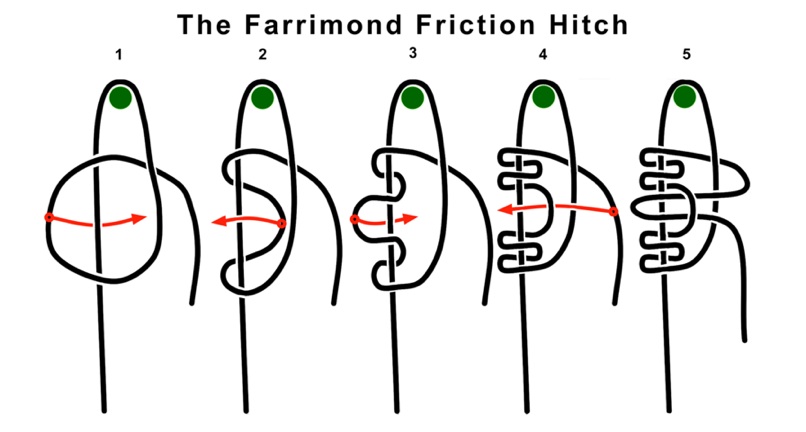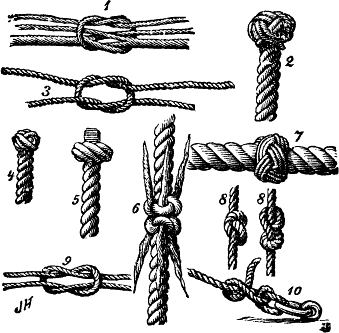|
Farrimond Friction Hitch
The Farrimond friction hitch is a quick release adjustable friction hitch for use on lines under tension. It is useful when the length of a line will need to be periodically adjusted in order to maintain or adjust tension whilst remaining quick and easy to untie; such as when hanging the ridge line for a Basha. It can be used in very effective conjunction with the Siberian hitch for this purpose. It can also be used as a mooring knot. History The first known presentation of this knot was made by British actor Barry Farrimond MBE in 2008 during a demonstration at the Yellow Wood Bush Camp, Wales. Tying The diagram below is shown from a birds eye perspective with the green dot representing a fixed point such as a tree or post which a ridge line might be attached to. After passing the working end around the back of this fixed point, create a loop that is then placed on top of the ridge line as in fig 1. Once this has been done take the loop and wrap it around the ridge line (foll ... [...More Info...] [...Related Items...] OR: [Wikipedia] [Google] [Baidu] |
Taut-line Hitch
The taut-line hitch is an adjustable loop knot for use on lines under tension. It is useful when the length of a line will need to be periodically adjusted in order to maintain tension. It is made by tying a rolling hitch around the standing part after passing around an anchor object. Tension is maintained by sliding the hitch to adjust the size of the loop, thus changing the effective length of the standing part without retying the knot. It is typically used for securing tent lines in outdoor activities involving camping, by arborists when climbing trees, for tying down aircraft, for creating adjustable moorings in tidal areas, and to secure loads on vehicles. A versatile knot, the taut-line hitch was even used by astronauts during STS-82, the second Space Shuttle mission to repair the Hubble Space Telescope. Naming The adjustable loop forms of the rolling hitch and Magnus hitch, in addition to being called either of those two names, have also come to be known variousl ... [...More Info...] [...Related Items...] OR: [Wikipedia] [Google] [Baidu] |
Prusik Knot
A Prusik ( ) is a friction hitch or knot used to attach a loop of cord around a rope, applied in climbing, canyoneering, mountaineering, caving, rope rescue, ziplining, and by arborists. The term Prusik is a name for both the loops of cord used to tie the hitch and the hitch itself, and the verb is "to prusik" or "prusiking" (i.e. using a Prusik to ascend). More casually, the term is used for any friction hitch or device that can grab a rope (see autoblock). Due to the pronunciation, the word is often misspelled Prussik, Prussick, or Prussic. The Prusik hitch is named after its putative inventor, the Austrian mountaineer Karl Prusik. It was shown in a 1931 Austrian mountaineering manual for rope ascending. It was used on several mountaineering routes of the era to ascend the final summit, where a rope could be thrown over the top and anchored so that climbers could attain the summit by prusiking up the other side of the rope. A Prusik made from cord does little or no damage to ... [...More Info...] [...Related Items...] OR: [Wikipedia] [Google] [Baidu] |
Siberian Hitch
The Siberian hitch (or Evenk knot) is a hitch knot used to attach a rope to an object. It is a type of slipped figure-eight noose. The hitch is known for having a tying method suitable even while wearing heavy gloves or mittens in cold climates. As a slipped knot it can be released simply by pulling the working end of the rope. History The hitch and its associated tying method were recorded in use among the Nenets people of northern Russia in the early 1990s. The knot's ease of tying and releasing while wearing cold weather gear was cited as a primary advantage. It was also used by Ray Mears during his bushcraft Bushcraft is the use and practice of skills to survive and thrive in a natural environment. Bushcraft skills include foraging, hunting, fishing, firecraft, and tying knots. Woodcraft is a subset of bushcraft that focuses on survival skills for ... television series. Tying While it can be tied by other methods, it is associated with the one demonstrated in t ... [...More Info...] [...Related Items...] OR: [Wikipedia] [Google] [Baidu] |
Friction Hitch
Friction is the force resisting the relative motion of solid surfaces, fluid layers, and material elements sliding against each other. Types of friction include dry, fluid, lubricated, skin, and internal -- an incomplete list. The study of the processes involved is called tribology, and has a history of more than 2000 years. Friction can have dramatic consequences, as illustrated by the use of friction created by rubbing pieces of wood together to start a fire. Another important consequence of many types of friction can be wear, which may lead to performance degradation or damage to components. It is known that frictional energy losses account for about 20% of the total energy expenditure of the world. As briefly discussed later, there are many different contributors to the retarding force in friction, ranging from asperity deformation to the generation of charges and changes in local structure. When two bodies in contact move relative to each other, due to these various ... [...More Info...] [...Related Items...] OR: [Wikipedia] [Google] [Baidu] |
Basha (tarpaulin)
A basha is a waterproof canvas or plastic sheet with eyelets or loops on the perimeter, which is used in camping, outdoor, or military situations to act as a shelter, in the form of an impromptu tent and/or groundsheet, usually supported with rope or even bungee cords attached to trees. Application Bashas are used by the military, particularly the British Army, the Australian Army (colloquially known as a "hooch", "hoochie," or "hutchie"), the New Zealand Army, and the Singapore Armed Forces as a shelter while in the field or on operations. They are lightweight and can be put up rapidly, and camouflaged simply with foliage specific to the area of operation. Their low profile gives them a small silhouette, and many are also infrared reflective, which makes them, and their occupants, less visible to infrared detection equipment. Normally bashas are erected in woods, as the trees both serve to give visual cover and support the basha through bungee cords or rope. Because they are ne ... [...More Info...] [...Related Items...] OR: [Wikipedia] [Google] [Baidu] |
Knot
A knot is an intentional complication in Rope, cordage which may be practical or decorative, or both. Practical knots are classified by function, including List of hitch knots, hitches, List of bend knots, bends, List of loop knots, loop knots, and Rope splicing, splices: a ''hitch'' fastens a rope to another object; a ''bend'' fastens two ends of a rope to each another; a ''loop knot'' is any knot creating a loop; and ''splice'' denotes any multi-strand knot, including bends and loops. A knot may also refer, in the strictest sense, to a stopper (knot), stopper or knob at the end of a rope to keep that end from slipping through a grommet or eye. Knots have excited interest since ancient times for their practical uses, as well as their Topology, topological intricacy, studied in the area of mathematics known as knot theory. History Knots and knotting have been used and studied throughout history. For example, Chinese knotting is a decorative handicraft art that began as ... [...More Info...] [...Related Items...] OR: [Wikipedia] [Google] [Baidu] |
Bight (knot)
In knot tying, a bight is a curved section or slack part between the two ends of a rope, string, or yarn.. "Any slack part of a rope between the two ends, particularly when curved or looped." A knot that can be tied using only the bight of a rope, without access to the ends, is described as in the bight. The term "bight" is also used in a more specific way when describing Turk's head knots, indicating how many repetitions of braiding are made in the circuit of a given knot. Bight vs. open loop Sources differ on whether an open loop or U-shaped curve in a rope qualifies as a bight. treats bights and loops as distinct, stating that a curve "no narrower than a semicircle" is a bight, while an open loop is a curve "narrower than a bight but with separated ends". However, ''The Illustrated Encyclopedia of Knots'' (2002) states: "Any section of line that is bent into a U-shape is a bight." Slipped knot In order to make a slipped knot (also slipped loop and quick release knot ... [...More Info...] [...Related Items...] OR: [Wikipedia] [Google] [Baidu] |
Farrimond Friction Hitch
The Farrimond friction hitch is a quick release adjustable friction hitch for use on lines under tension. It is useful when the length of a line will need to be periodically adjusted in order to maintain or adjust tension whilst remaining quick and easy to untie; such as when hanging the ridge line for a Basha. It can be used in very effective conjunction with the Siberian hitch for this purpose. It can also be used as a mooring knot. History The first known presentation of this knot was made by British actor Barry Farrimond MBE in 2008 during a demonstration at the Yellow Wood Bush Camp, Wales. Tying The diagram below is shown from a birds eye perspective with the green dot representing a fixed point such as a tree or post which a ridge line might be attached to. After passing the working end around the back of this fixed point, create a loop that is then placed on top of the ridge line as in fig 1. Once this has been done take the loop and wrap it around the ridge line (foll ... [...More Info...] [...Related Items...] OR: [Wikipedia] [Google] [Baidu] |
List Of Friction Hitch Knots
A list is a Set (mathematics), set of discrete items of information collected and set forth in some format for utility, entertainment, or other purposes. A list may be memorialized in any number of ways, including existing only in the mind of the list-maker, but lists are frequently written down on paper, or maintained electronically. Lists are "most frequently a tool", and "one does not ''read'' but only ''uses'' a list: one looks up the relevant information in it, but usually does not need to deal with it as a whole".Lucie Doležalová,The Potential and Limitations of Studying Lists, in Lucie Doležalová, ed., ''The Charm of a List: From the Sumerians to Computerised Data Processing'' (2009). Purpose It has been observed that, with a few exceptions, "the scholarship on lists remains fragmented". David Wallechinsky, a co-author of ''The Book of Lists'', described the attraction of lists as being "because we live in an era of overstimulation, especially in terms of information, ... [...More Info...] [...Related Items...] OR: [Wikipedia] [Google] [Baidu] |
List Of Knots
This list of knots includes many alternative names for common knots and lashings. Knot names have evolved over time, and there are many conflicting or confusing naming issues. The overhand knot, for example, is also known as the thumb knot. The figure-eight knot is also known as the Savoy knot or the Flemish knot. A * Aberdeen knot - preferred for closure of intradermal sutures * Adjustable bend – can be easily lengthened or shortened * Adjustable grip hitch – a simple hitch which may easily be shifted up and down the rope while slack * Albright special – used to tie two different diameters of line together, for instance to tie monofilament to braid *Alpine butterfly (also known as a butterfly loop) – a static loop mostly used by mountain climbers and rappellers for securing a carabiner to static rope * Alternate ring hitching – covering a ring in hitching can prevent damage * Anchor bend – attaching a rope to a ring or similar termination * Angler's loop – ... [...More Info...] [...Related Items...] OR: [Wikipedia] [Google] [Baidu] |
Prusik
A Prusik ( ) is a friction hitch or knot used to attach a loop of cord around a rope, applied in climbing, canyoneering, mountaineering, caving, rope rescue, ziplining, and by arborists. The term Prusik is a name for both the loops of cord used to tie the hitch and the hitch itself, and the verb is "to prusik" or "prusiking" (i.e. using a Prusik to ascend). More casually, the term is used for any friction hitch or device that can grab a rope (see autoblock). Due to the pronunciation, the word is often misspelled Prussik, Prussick, or Prussic. The Prusik hitch is named after its putative inventor, the Austrian mountaineer Karl Prusik. It was shown in a 1931 Austrian mountaineering manual for rope ascending. It was used on several mountaineering routes of the era to ascend the final summit, where a rope could be thrown over the top and anchored so that climbers could attain the summit by prusiking up the other side of the rope. A Prusik made from cord does little or no damag ... [...More Info...] [...Related Items...] OR: [Wikipedia] [Google] [Baidu] |
Hitch Knots
Hitch may refer to: People * Hitch (surname) * nickname of director Alfred Hitchcock (1899-1980) * nickname of writer Christopher Hitchens (1949–2011) Other uses * Hitch (knot), a knot used to attach a rope to a fixed object * Tow hitch, a construction on a truck or car to attach a trailer * Hitches, fishes in the genus ''Lavinia'' including ''Lavinia exilicauda'' * Hitch (route), a pattern run by a receiver in American football * ''Hitch'' (film), a 2005 comedy film starring Will Smith * ''Hitch'' (album), a 2016 album by The Joy Formidable * Healthcare Interoperability Testing and Conformance Harmonisation, a 2010-2011 European Institute for Health Records The European Institute for Health Records or EuroRec Institute is a non-profit organization founded in 2002 as part of the ProRec initiative. On 13 May 2003, the institute was established as a non-profit organization under French law. Current Pre ... project See also * Hitching (other) * The Hitcher (dis ... [...More Info...] [...Related Items...] OR: [Wikipedia] [Google] [Baidu] |





